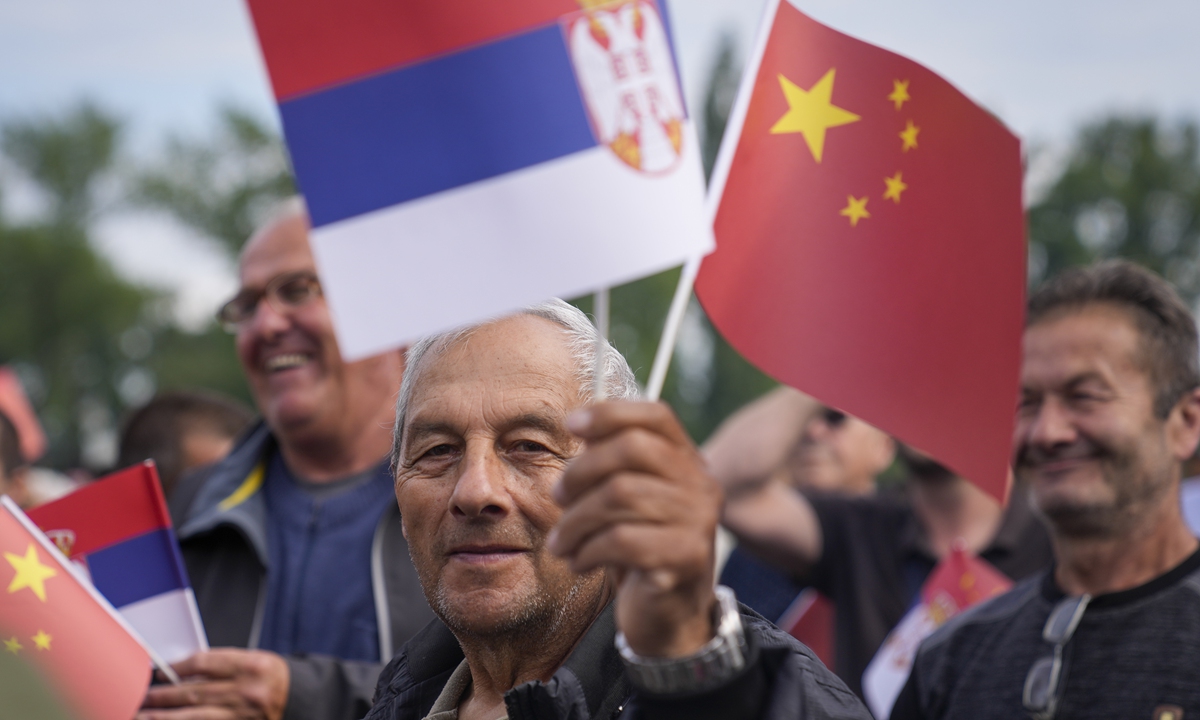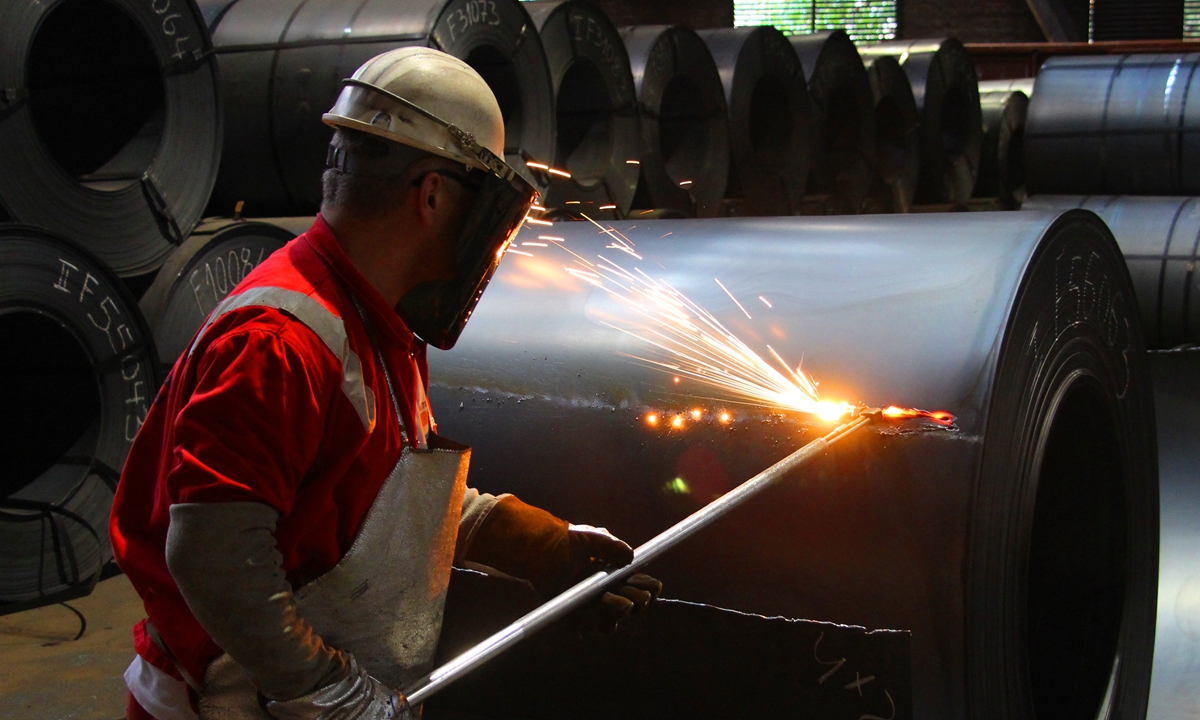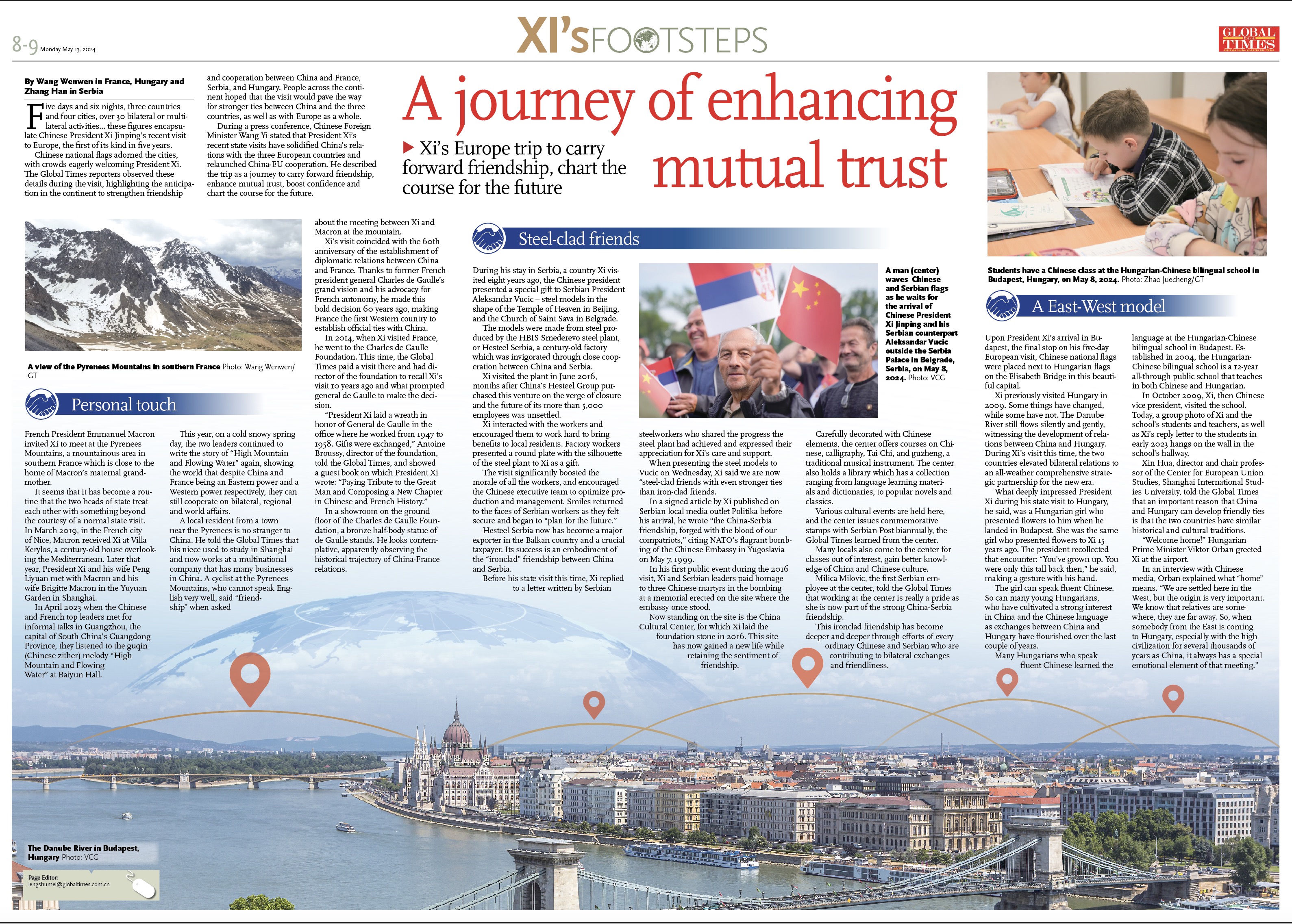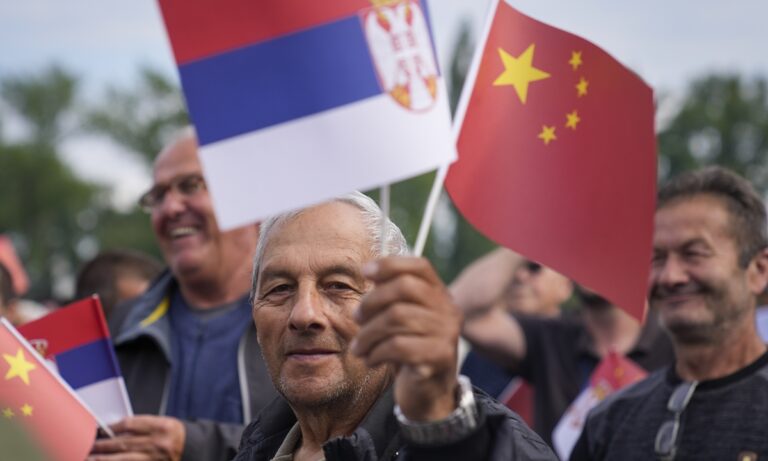
A man (center) waves the Chinese and Serbian flags as he awaits the arrival of Chinese President Xi Jinping and Serbian President Aleksandar Vucic outside the Palace of Serbia in Belgrade, Serbia, May 8, 2024. Photo: VCG
Five days, six nights, four cities in three countries, more than 30 bilateral and multilateral activities… these are the figures that summarise Chinese President Xi Jinping’s first visit to Europe in five years.
Chinese flags decorated the cities and crowds enthusiastically welcomed President Xi Jinping. A Global Times reporter observed this during his visit, highlighting the hopes of the continent to strengthen friendship and cooperation between China and the three countries, France, Serbia and Hungary. People on the continent hoped that this visit would pave the way for stronger ties between China and the three countries and the whole of Europe.
Chinese Foreign Minister Wang Yi told a news conference that President Xi Jinping’s recent state visit has strengthened China’s ties with the three European countries and resumed China-EU cooperation.
Wang, who is also a member of the Political Bureau of the Communist Party of China Central Committee, said Xi’s European visit is a journey to advance friendship, enhance mutual trust, boost self-confidence and chart a path for the future.

View of the Pyrenees in southern France. Photo: Wang Wenwen/GT
Human contact
French President Emmanuel Macron invited Xi to meet in the mountainous Pyrenees in southern France, close to the hometown of Macron’s maternal grandmother.
It seems to be becoming commonplace for the leaders of the two countries to treat each other with something beyond the usual courtesies of a state visit: In March 2019, Macron hosted Xi Jinping in Nice, France, at Villa Kérylos, a century-old mansion overlooking the Mediterranean Sea. Later that year, Xi and his wife Peng Liyuan met with Macron and his wife Brigitte Macron at Shanghai’s Yu Garden.
In April 2023, when the top leaders of China and France held an informal meeting in Guangzhou, the capital of southern China’s Guangdong Province, they listened to the guqin (Chinese zither) melody “High Mountains and Flowing Water” at the Baiyun Hall.
This year, on a cold and snowy spring day, the two leaders continued to write the story of “high mountains and flowing water”, showing the world that although China and France are an Eastern and Western power respectively, they can still cooperate on bilateral, regional and global issues.
For a local resident of a town near the Pyrenees, China is no stranger to the country. He told the Global Times that his niece once studied in Shanghai and now works for a multinational company with a large presence in China. He was cycling in the Pyrenees and spoke poor English, but when asked about Xi and Macron’s meeting in the mountains, he replied, “friendship.”
Xi’s visit coincided with the 60th anniversary of the establishment of diplomatic relations between China and France. It was former French President General Charles de Gaulle’s grand vision and defense of French autonomy that led him to take this bold decision 60 years ago, making France the first Western country to officially establish relations with China.
During his visit to France in 2014, President Xi Jinping visited the Foundation Charles de Gaulle. The Global Times visited the Foundation this time and asked the Foundation’s chairman to look back on President Xi’s visit 10 years ago and explain why General de Gaulle made this decision.
“President Xi Jinping laid a wreath in memory of General de Gaulle at the office where he worked from 1947 to 1958. Gifts were exchanged,” the foundation’s president, Antoine Broussy, told the Global Times, showing a guest book in which Xi had written “paying tribute to a great man and writing a new chapter in the history of China and France.”
In a ground-floor exhibition room at the Charles de Gaulle Foundation stands a bust of de Gaulle, his expression pensive, seemingly observing the historical trajectory of Sino-French relations.

Serbian workers from HBIS Serbia wearing protective masks produce steel at the factory. Photo: Courtesy of HBIS Serbia
Steel Companion
During Xi’s visit to Serbia eight years ago, he presented a special gift to Serbian President Aleksandar Vucic: steel models of the Temple of Heaven in Beijing and the Church of St. Sava in Belgrade.
The model was made from steel produced at HBIS Smederevo Steelworks (also known as Hesteel Serbia), a century-old factory that has been revitalized through close cooperation between China and Serbia.
Xi visited the plant in June 2016, months after China’s Hebei Iron and Steel Group bought the operation on the brink of closure, raising doubts about the future of more than 5,000 employees.
Xi interacted with the workers, encouraging them to work hard to benefit local residents. Factory workers presented him with a round plate bearing the silhouette of the steel mill.
The visit greatly boosted the morale of all workers and encouraged the Chinese management to optimize production and management. Smiles returned to the faces of the Serbian workers, they felt at ease and started “planning for the future.”
Hestir Serbia has now become a major exporter and important taxpayer in the Balkans, and its success reflects the “iron-clad” friendship between China and Serbia.
Ahead of his state visit, Xi responded to a letter written by Serbian steelworkers, informing them of the progress at the steelworks and expressing his gratitude for Xi’s care and support.
While presenting a steel model to President Vucic on Wednesday, President Xi said that we are now “steel-clad friends, bound by a bond even stronger than iron-clad friends.”
In a signed article published in local media outlet Politika before his arrival in Serbia, Xi cited the violent bombing of the Chinese embassy in Yugoslavia by NATO on May 7, 1999, and wrote that “the friendship between China and Serbia is forged with the blood of brothers.”
At the first official event during the 2016 visit, Xi and Serbian leaders paid tribute to three Chinese martyrs in the bombing at a memorial erected on the site of the country’s former embassy.
Today, the site is home to the China Cultural Center, for which President Xi Jinping laid the cornerstone in 2016. The site has now been given new life while preserving that sentiment of friendship.
Decorated with Chinese influences, the centre offers courses in Mandarin, calligraphy, Tai Chi and the traditional Guzheng instrument, and also houses a library with an extensive collection ranging from language materials and dictionaries to popular novels and classics.
Various cultural events are held there, and the centre issues commemorative stamps biannually in collaboration with Serbian Post, the Global Times heard from the centre.
Many local people are also interested in attending the centre’s classes to deepen their understanding of China and Chinese culture.
Milica Milovic, the centre’s first Serbian staff member, told the Global Times that it was indeed an honor to work at the centre, now that it has become part of the strong friendly relations between China and Serbia.
This strong friendship has been further strengthened through the efforts of all ordinary Chinese and Serbian people who contribute to exchanges and friendly relations between our two countries.
East-West Model
As President Xi Jinping arrived in Budapest, the final destination of his five-day European visit, the Chinese flag was raised next to the Hungarian flag on the capital’s beautiful Elisabeth Bridge.
President Xi Jinping visited Hungary in 2009. Some things have changed, some things have remained the same. The Danube River still flows calmly and gently, watching the development of China-Hungary relations. President Xi’s visit this time has elevated the relationship between the two countries to a new era of all-weather comprehensive strategic partnership.
Xi said that during his state visit to Hungary, he was deeply impressed by a Hungarian girl who presented him with flowers upon his arrival in Budapest. The girl was the same one who had presented Xi with flowers 15 years ago. Recalling the encounter, Xi said, “You’ve grown up. You were this tall back then,” and shook her hand.
The girl can speak fluent Chinese. In recent years, as exchanges between China and Hungary have flourished, many young people in Hungary who have developed a strong interest in China and the Chinese language can also speak Chinese. At Buda Castle, the historic castle and palace complex of the Hungarian kings, almost half of the tourists are from China and are accompanied by tour guides who can speak Chinese very well.
Many Hungarians who speak fluent Chinese learned their language at the Hungarian-Chinese Bilingual School in Budapest, a 12-year, full-year public school founded in 2004 that teaches in both Chinese and Hungarian.
In October 2009, then-Chinese Vice President Xi Jinping visited the school during his visit to Hungary. Today, on the wall of the school’s corridor is a group photo of Xi Jinping with the school’s students and teachers, as well as a reply letter that Xi wrote to the students in early 2023.
Xin Hua, director and chair professor of the Center for European Union Studies at Shanghai International Studies University, told the Global Times that an important reason for China and Hungary to build friendly relations is that the two countries have similar historical and cultural traditions.
“Welcome back!” Hungarian Prime Minister Viktor Orbán greeted Xi at the airport. The next day, Xi was greeted with a military ceremony in the Lions’ Courtyard of Buda Castle.
In an interview with Chinese media, Hungarian Prime Minister Orban explained the meaning of “hometown.”
“Even though we are settled here in the West, place of origin is very important, so we know that we have relatives somewhere, they are far away. So when someone from the East comes to Hungary, especially in a country like China that has had an advanced civilisation for thousands of years, there is always a special emotional element to that encounter,” Orban said.

A journey to deepen mutual trust

